
 |
|
#151
|
|||
|
|||
|
Something a bit more update in this thread, a few early shots of the German built amphbious bridging and ferrying M2
|
|
#152
|
|||
|
|||
|
I thought my RE book on bridging would tell me where this bridge was built especially as it has a couple of features such as the wrecked barge in the forgound and the large names or adverts on the distant building but no such luck so who has any details. I think its a class 40 bridge
cheers Les |
|
#153
|
|||
|
|||
|
Hello Les,
What a beautiful image! I always love seeing new (to me!) photos of Crabs, and this one is reallly nice. Looking at it, I was feeling that the hills in the background, the buildings, quays and barge had a definite "Seine" flavour to them. Then a tiny bell rang somewhere in the back of my head, and prompted me to check the Lothians War Diary and, sure enough, here it was (from War Diary 'A' Sqn 1 Lothians & Border Yeomanry): "28 Aug [1944] The Sqn crossed the Seine at Elbeuf behind the armd bde, highly organised with marshalling areas etc and the bridge - a Bailey single tier on pontoons - quite easy for us. We harboured in the valley on the East bank and were engaged by sporadic mortar and 88mm shellfire, not to forget tempestuous rain." No sign of "tempestuous rain" on the photo (it probably came during the evening), but the description of the bridge certainly fits. Then I looked up Elbeuf on GoogleEarth, but no luck, nothing recognizable as no old buildings remained. So I resorted to one of my favorite time machines, an invaluable website which seems to have old postcards about every single hamlet in France, and yielded literally THOUSANDS on Elbeuf alone: https://www.delcampe.fr/fr/collectio...earch_mode=all And bingo! This is indeed Elbeuf! The pontoon bridge was built just a few yards downstream of the old suspension bridge, which had been destroyed by then (I took the liberty of posting Les' photo again for easier comparison): 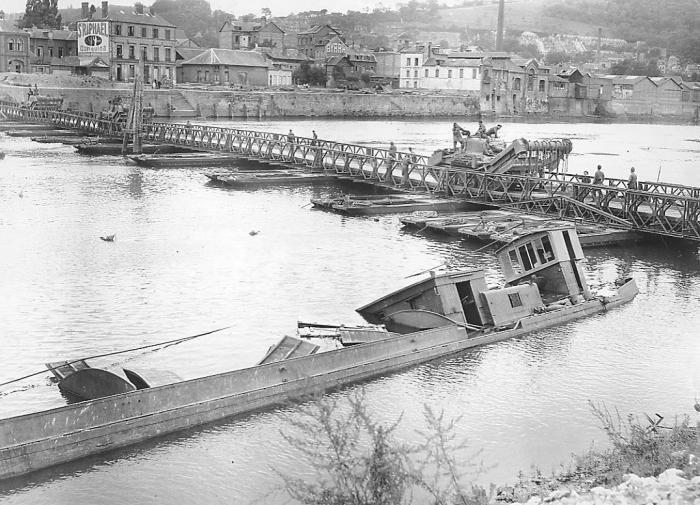 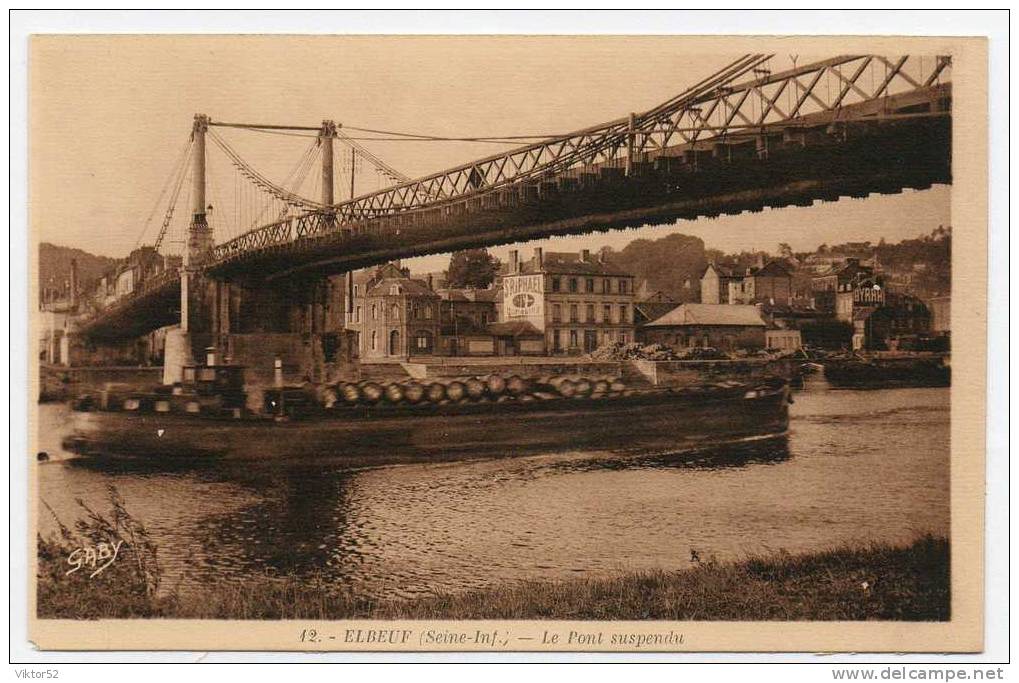 A postwar photo this time, shot from nearly the same angle, but from further back and much higher up: an oblique aerial view of the new suspension bridge ("Pont Guynemer") which replaced the old one. The various buildings are clearly visible: 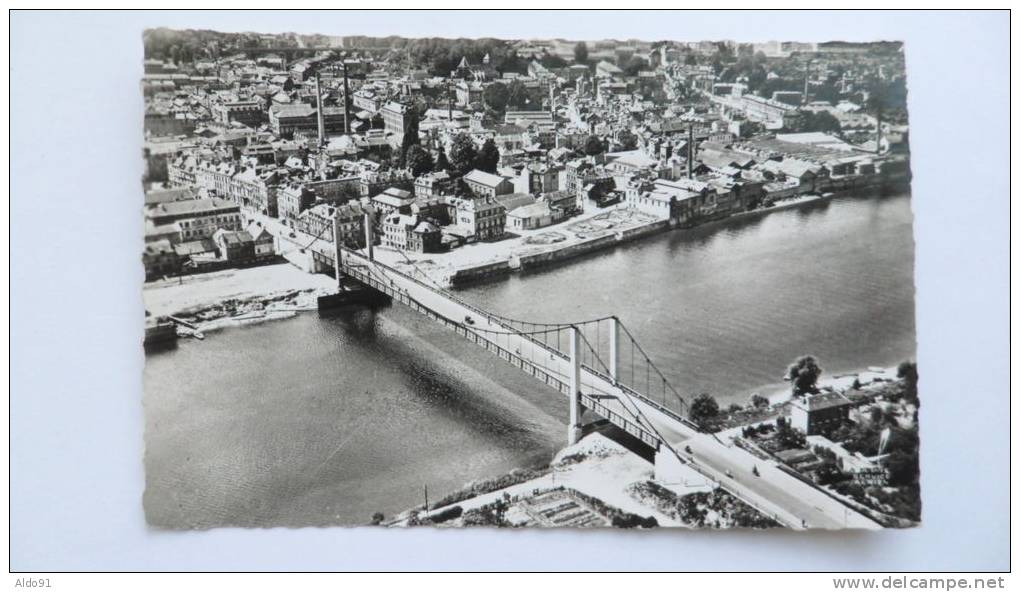 Back to prewar postcards, here's a view from the bridge itself. The corner house on the right is the one just right of the bridge pile on the previous postcard: 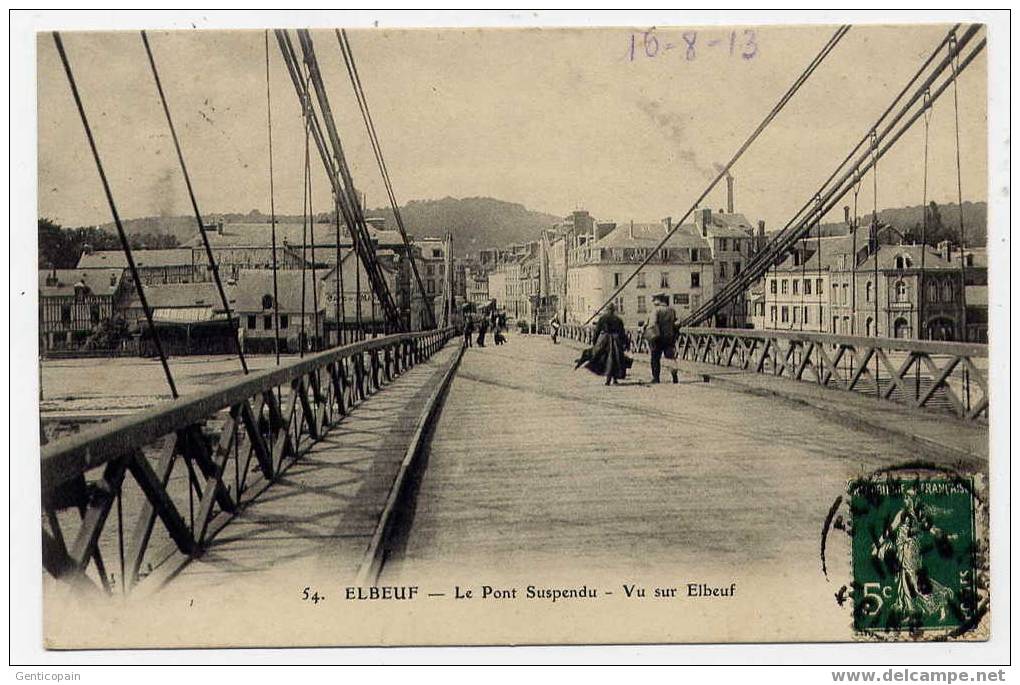 Still from the East bank, but from the right side of the bridge (just right or downstream of the above 2 pics): the photographer's location is more or less where the pontoon bridge lands: 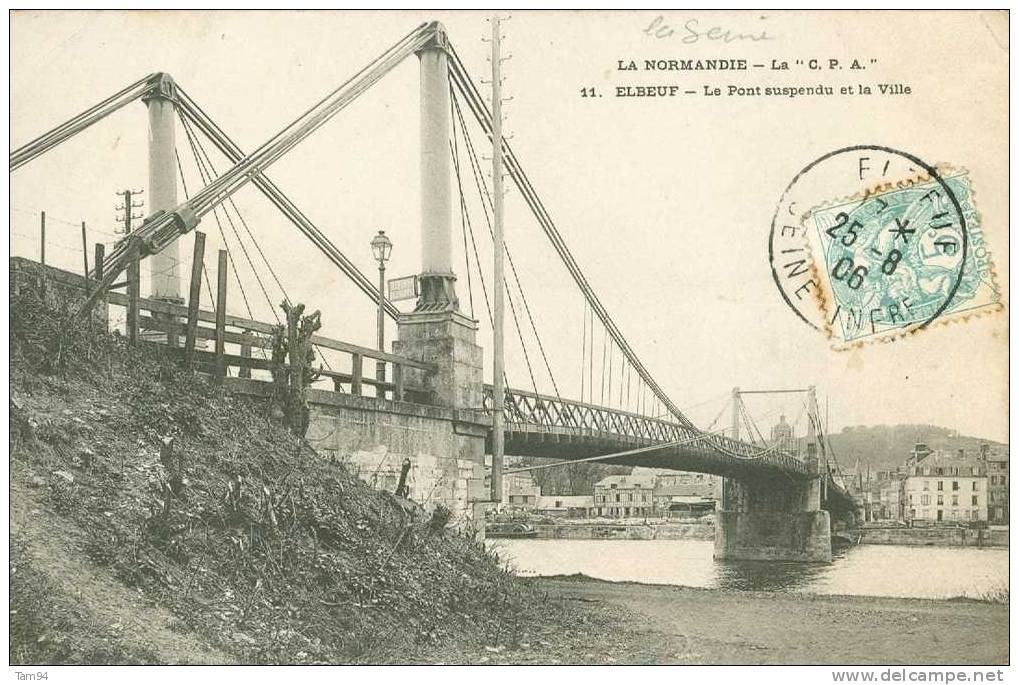 Another view, from further upstream (left) this time, still from the same side (East bank) of the river. The wooden posts around the middle of the pontoon bridge seem to correspond with the centre pile of the old suspension bridge: 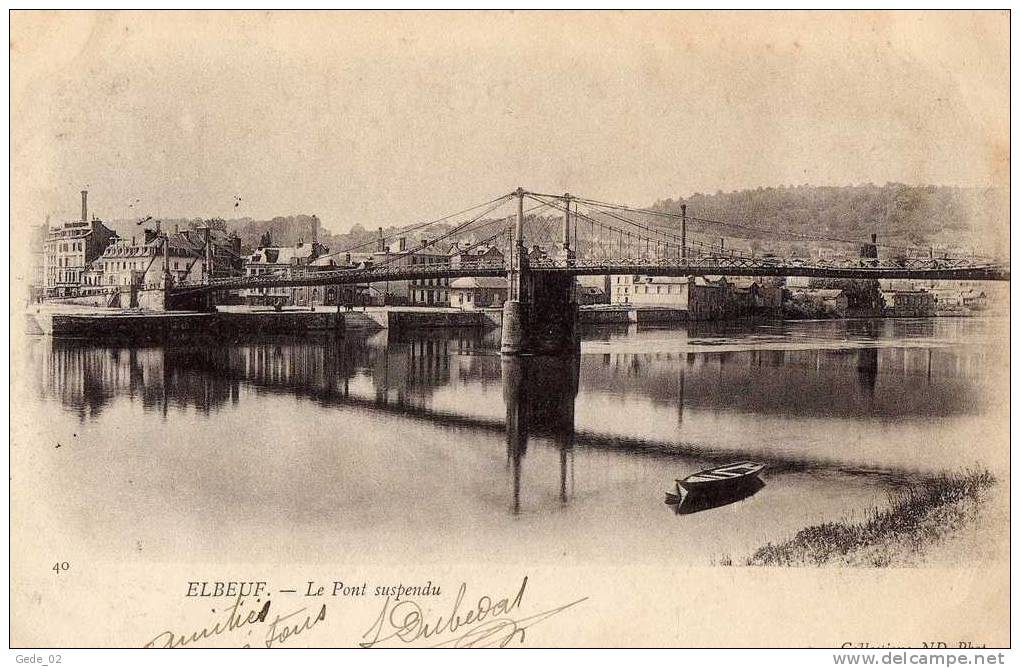 The areas to the left and to the right of the bridge on the West bank (the far bank on the above photos) are the quays of Elbeuf ("Le Port"), were the Seine barges loaded or unloaded their goods. Here's a close up of "Le Port" (the large house on the left is the one with the "St RaphaŽl" advert, and the white building with the chimney to the right is one of the textile dyeing works): 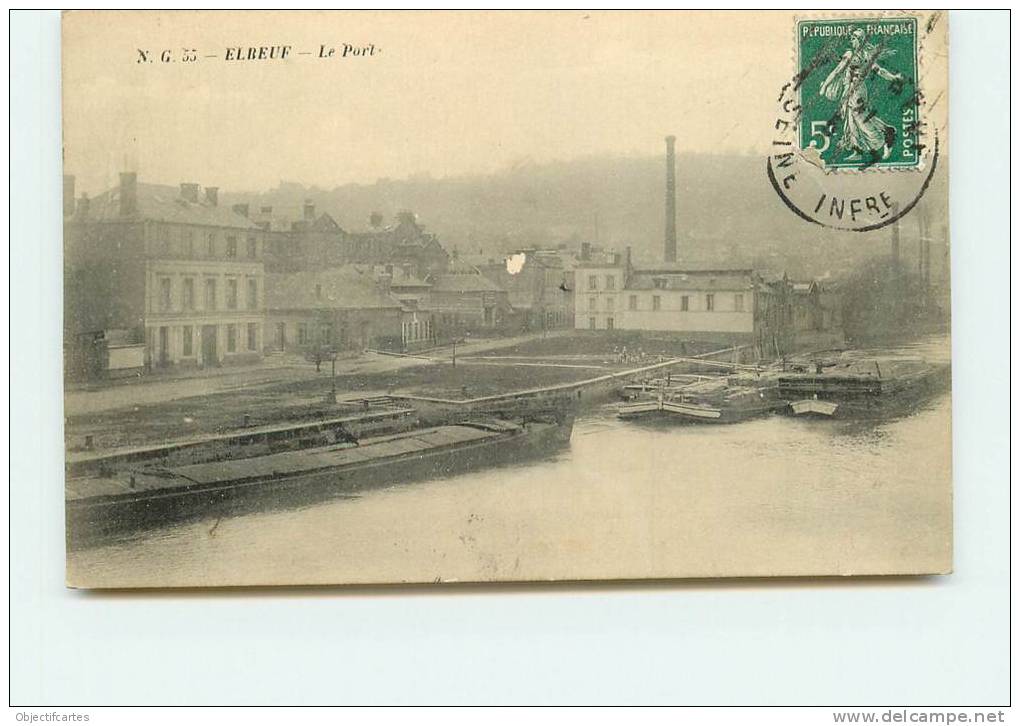 The dyeworks and their chimneys: 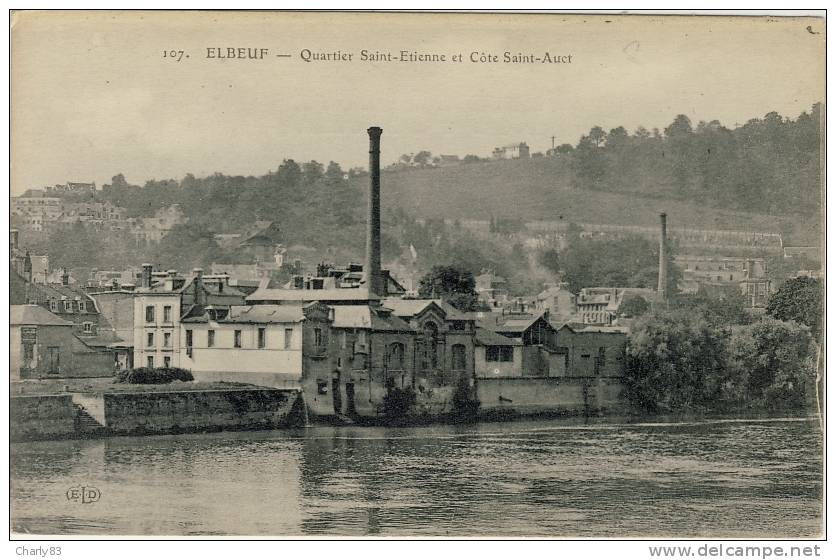 Here's a view from the West bank. The photographer of the pontoon bridge took the shot from the opposite bank, probably perched on the ruins of the old suspension bridge pile there. The pontoon bridge started from the stairs on the left foreground of the photo (where a couple of boats are tied): 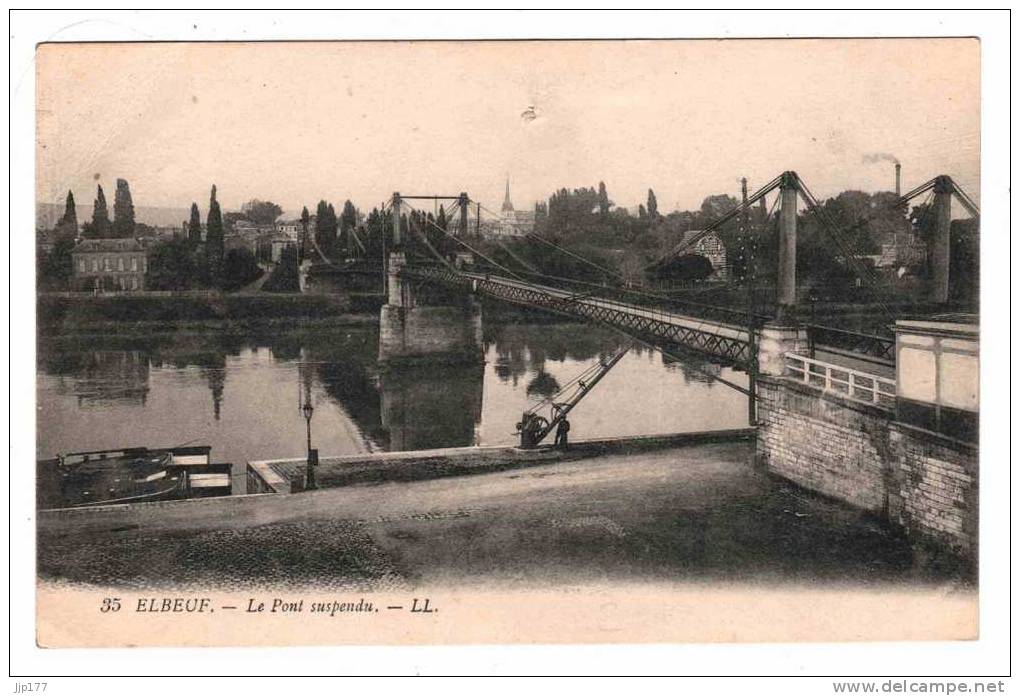 A general view of the quays and bridge from upstream on the West bank. The dyeworks can be seen just beyond the bridge pile on the left: 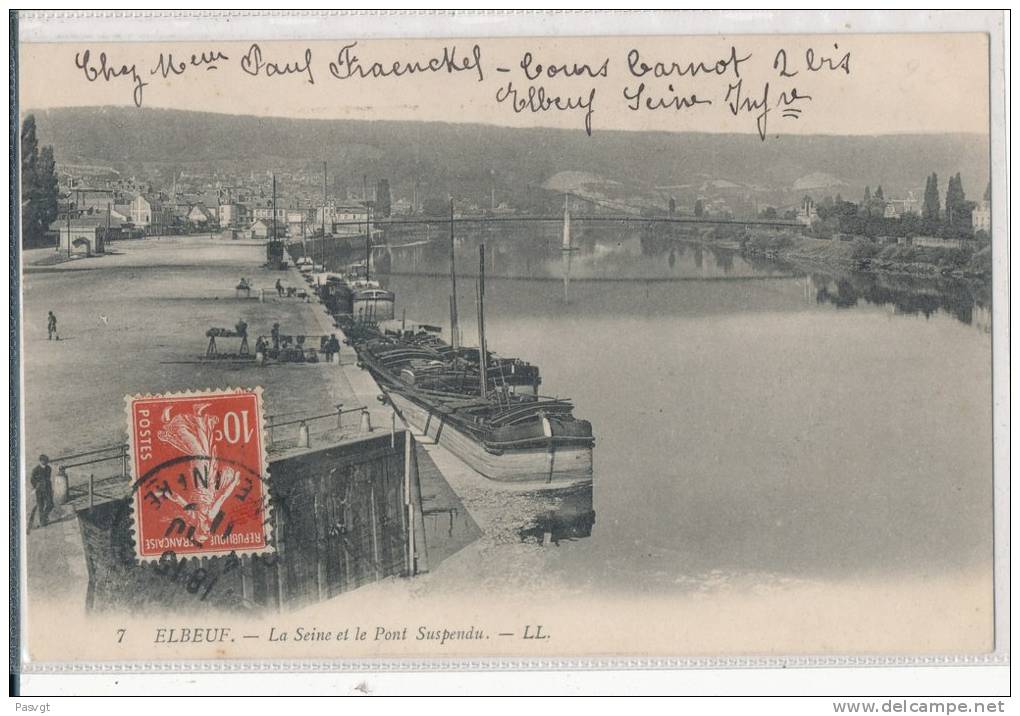 Les, do you have a higher resolution version of your photo, where perhaps we can see the Crabs better? Michel Sabarly Last edited by MicS; 25-08-17 at 09:59. Reason: Display images instead of just links |
|
#154
|
|||
|
|||
|
From Report No. 183, "Canadian Participation in the operations in North West Europe, 1944.
Part IV: First Canadian Army in the Pursuit (23 Aug - 30 Sep)" (Historical Section, Canadian Military Headquarters), page 77: (to be found here: http://www.cmp-cpm.forces.gc.ca/dhh-...ype=2&RfId=183) "89. The Engineers lost no time in bridging the Seine. As we have seen, by 1030 hours on the 27th light rafts were taking traffic at Elbeuf and tanks were being ferried over on two Class 40 rafts before nightfall (see pra 79). The first bridge, a Class 9 F.B.E. (Folding Boat Equipment) was completed at Elbeuf by 2100 hours after twelve hours work by 2 Cdn Corps Tps Engineers with 13 A.G.R.E. and 1 Cdn A.G.R.E. under command (W.D., C.E. H.Q. 2 Cdn Corps, 27 Aug 44). Work begun that morning by 8 G.H.Q. Tps R.E. on construction of a Class 40 Bailey Pontoon Bridge in Elbeuf (113990) was finished at 0730 hours on the 28th (W.D., H.Q. 1 Cdn A.G.R.E., 28 Aug 44). These two bridges supplemented the ferries in carrying the load of the crossings at Elbeuf for the first three days, and a third bridge (a Class 40 Bailey Pontoon) was completed by 8 G.H.Q. Tps R.E. (at 120988) on 30 Aug (Ibid: 30 Aug 44)." The NAC has a series of photos, some online, including (in approx. chronological order): PA-136016: "Storm boats manned by the 34th Field Company, R.C.E., carry Regina Rifles Regiment's 7th Brigade over the Seine River." Elbeuf 26 Aug 44 PA-135958: "M3 half-track vehicle crossing the Seine River on a pontoon raft." Elbeuf, 27 Aug 44 PA-143941: Canadians in France - Anti-tank gun and jeep ambulance loaded in craft and carried over the[sic, caption stops here] ." Elbeuf 26 Aug 44 PA-137295: "8th G.H.Q. Troops English Engineers assemble floating Bailey Bridge, Elbeuf, France, 27 August 1944." PA-136015, PA-131344: "16th Field Engineers starting to build a Pontoon bridge over the [Seine at Elbeuf, 27 August 1944.]." PA-136158: "Line of Stuart and Sherman tanks waiting to cross the bridge." Elbeuf, 27 Aug 44 PA-144143: "General Motors 'Staghound' T17E1 armoured cars of the 18th Armoured Car Regiment (12th Manitoba Dragoons) crossing the Seine River." Elbeuf, 28 Aug 44 PA-137296: "A General Motors Staghound T-17E1 armoured car of the 12th Manitoba Dragoons crossing a Bailey bridge, Elbeuf, France, 28 August 1944." PA-113663, PA-113662: "[Vehicles of the 4th Canadian Armoured Division crossing pontoon bridge over the Seine River near Elbeuf, France, 28 August 1944.]." PA-133660: ['Sherman' tank crossing pontoon bridge over the Seine River near Elbeuf, France, 28 August, 1944.]." PA-116585: "Lieutenant-General Guy Simonds (left) and Captain Marshall Stearns watching 'Sherman' tanks of the Canadian Grenadier Guards crossing the Seing [sic] River." Elbeuf, 28 Aug 44 Here are some of them, plus a few others from various sources, starting on 28 Aug 44: Seen from the East bank (right bank of the river, actually more to the North at this point of the large meander of the Seine): "General Motors 'Staghound' T17E1 armoured cars of the 18th Armoured Car Regiment (12th Manitoba Dragoons) crossing the Seine River." Elbeuf, 28 Aug 44 (NAC PA-144143) https://flic.kr/p/rY3Cj9 "Railway ties are unloaded from the back deck of a 12th Manitoba Dragoons Staghound armoured car to stabilize the exit from the pontoon bridge at Elbeuf, 28 August 1944" (NAC PA-137296): https://flic.kr/p/nEZVkN On the West (or South, left) bank this time, we see the entrance to the bridge (NAC PA-113663): https://www.flickr.com/photos/76813382@N06/14408048701/ https://flic.kr/p/nXc1UM Source: http://ww2talk.com/index.php?threads...10/#post-80095 Edit: some of the photos, including this one, have disappeared from the linked thread following ww2talk's changeover to a new software... The link to Juno Beach Centre in the linked post is now also dead, and I could not find the photo in the new website. The same photo, larger but cropped: https://flic.kr/p/rHSVXx Source: http://canada.virtual.museum/pm.php?...%2C+Canada&ci= Still on the West/South bank, we can see that the stairs have been removed to make a gentler slope down to the bridge: "Vehicles of the 4th Canadian Armoured Division crossing pontoon bridge over the Seine River near Elbeuf, France, 28 August 1944." (NAC PA-113662): https://flic.kr/p/nEZUPs |
|
#155
|
|||
|
|||
|
"'Sherman' tank crossing pontoon bridge over the Seine River near Elbeuf, France, 28 August, 1944." (NAC PA-113660):
Source: "No Price Too High: Canadians and the Second World War" by J. T. Copp & Richard Nielsen, page 180. Edit: the Sherman tank has been identified as the mount of Major AGV Smith, CO of No.1 Squadron, Governor General's Foot Guard. See http://ww2talk.com/index.php?threads...-2#post-635619 https://www.flickr.com/photos/76813382@N06/14224818320/ Now on 2 Sep 44 (by this time nice signs had been made!): "Children wave as a Sherman tank and vehicles of 152nd Brigade, 51st Highland Division, cross a pontoon bridge over the Seine at Elbeuf, 2 September 1944." (IWM BU 1515): THE BRITISH ARMY IN NORTH-WEST EUROPE 1944-45. © IWM (BU 1515) IWM Non Commercial Licence Another similar IWM photo: "Children wave as lorries of 51st (Highland) Division cross the Seine on a pontoon bridge at Elbeuf, 2 September 1944." (IWM BU 1516): THE BRITISH ARMY IN NORTH-WEST EUROPE 1944-45. © IWM (BU 1516) IWM Non Commercial Licence And finally, I just only found the following photo on this ww2talk thread: http://ww2talk.com/index.php?threads...ocation.36929/ Edit: again, some of the photos, including this one, have disappeared from the linked thread following ww2talk's changeover to a new software... The name of the bridge (GRAY, also visible on one of the photos above) and location are both spelled out in the captions, and there's even a photo of the other bridge at Elbeuf (ROSCOE)! (Photos courtesy Malcolm Snelgrove, who initiated the above ww2talk thread) (possibly IWM BU 1514 or 1517): https://flic.kr/p/nEZUJ7 Malcolm made a brilliant book for his father about his grandfather's service in 89 and later 90 Fd Coy RE: http://www.photobox.co.uk/creation/744338101 From this book, here's an extract from the War Diary of 89 Fd Coy RE: "August 26th 1944 Coy moved to Le Hottelerie along with 90 Field Coy on route for construction of bridges over Seine at Elbeuf. August 27th 1944 Coy moved to La Haye Malherbe, construction on bridges over Seine at Elbeuf commenced by 8th GHQ Troops. 1st bridge completed on 28th August at 02:00 "Gray" Bridge named after A.A. Gray [Maj Andrew Aitken GRAY P/154298, OC 89 Fd Coy RE]. 2nd Bridge "Roscoe" completed 30th August 13:00." From the same source, a drawing showing the locations of the ELBEUF bridges (BRIDGE I is GRAY br, BRIDGE III is ROSCOE br - note that sketch top is roughly SW): https://flic.kr/p/nEZSRY Incidentally, I also just found this other ww2talk thread where Les asked the same question and was given the correct location by Mike-Trux over a year ago. Well done Mike! http://ww2talk.com/index.php?threads...-8#post-381027 |
|
#156
|
|||
|
|||
|
Michel,
This is a wealth of information, with some magnificent photos. Thank you for taking the trouble to post. Is that one of the four seat Bofors Blitz crossing behind the Jeep?? Rich.
__________________
C60S Austin Champ x 2 Humber 1 Ton & Trailer |
|
#157
|
||||
|
||||
|
Crass, self-serving, commercial, message follows;
John Sliz has authored three booklets on Engineer bridging that may be of interest to the membership;    Available from www.servicepub.com/weapons.html
__________________
Those who live by the sword will be shot by those of us who have progressed. - M38A1, 67-07800, ex LETE |
|
#158
|
|||
|
|||
|
Quote:
 . All I can say is that the markings show the 51 (Highland) Div 'HD' emblem, and that the AoS number on the right should read '47', for 40 LAA Regt. . All I can say is that the markings show the 51 (Highland) Div 'HD' emblem, and that the AoS number on the right should read '47', for 40 LAA Regt.
|
|
#159
|
|||
|
|||
|
Are my eyes deceiving me...... I realize the pictures are grainy but.....
The wooden decking on the bridge seems to be getting more and more worn/chewed up by the traffic...... no doubt the tank tracks must have been nasty to a wooden deck....... early pictures seem to show moderate wear with a reasonable intact middle section....later pictures the centre unworn section is very narrow...... Would the deck beams need to be replaced often......??? If the instruction sign for constant first gear speed was respected the CMP vehicle speed must have been about the pace kept by an infantry man ...approx... 3 mph.....????? and slower for a tank..? Thanks for posting.
__________________
Bob Carriere....B.T.B C15a Cab 11 Hammond, Ontario Canada |
|
#160
|
|||
|
|||
|
Michel better late than never here is a close up of the crab tank on the bridge i hope it provides details you are looking for
cheers Les |
|
#161
|
|||
|
|||
|
Les,
Thanks a lot for posting this close-up. The turret number '21' is consistent with 'A' Squadron, and would make this tank part of 2 Troop 'A' Sqn 1 Lothians. Other markings are not readable but could include the AoS number '52', the tank name and T-number, plus maybe some loading code: 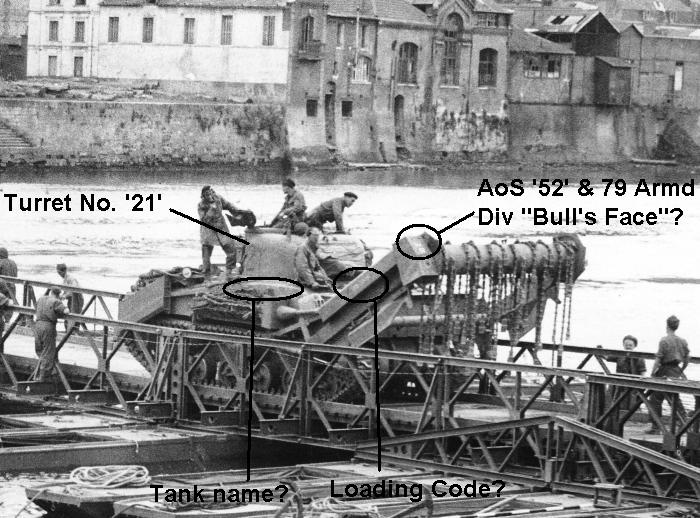 The name of the tank should be one of these four, since No.20 was RHODERICK DHU T212645, see http://proxy.handle.net/10648/ac053d...8-003048976d84 ROB ROY RED DOUGLAS RED COMYN RED TOD Maybe the name could be guessed if the original photo is a good print and could be further enlarged ? Last edited by MicS; 25-08-17 at 08:58. Reason: update link - thanks to Hanno Spoelstra for pointing the new link to me |
|
#162
|
|||
|
|||
|
Hello Les,
As ever looking for more Crab pictures, I stumbled upon what is certainly a large scan of yours here: http://www.flickr.com/photos/6738464...n/photostream/ Here's an extract that shows that with a very high probability it must have been named RED COMYN, as the other three possible names (ROB ROY, RED DOUGLAS and RED TOD) do not fit, wheras the first letter after what does resemble the word 'RED' looks very much like a 'C', and the length and shape of the second word look just about right for 'COMYN': 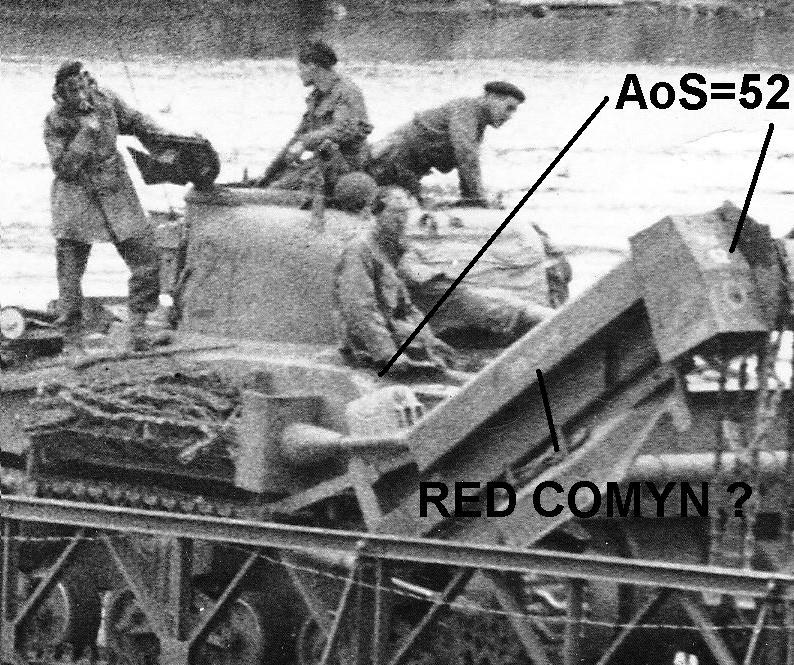 There is however a measure of doubt remaining, as 1 Lothians tank names were normally painted (red with a white shadowing) on the hull sides, but there seems to have been exceptions such as (possibly) 'COEUR DE LION', painted on the flail jibs because the various stowage items would have obscured them if painted on the hull. The Arm of Service number 52 (white over red square) is clearly recognizable on the front of the jib (with the yellow circle of the bridging class below), and can be guessed on its other customary location in 1 Lothians on the top right corner of the hull front plate. Crossing a Bailey bridge with a Crab was visibly a precision job, with a very watchful crew member each side assisting the driver, and the other two guys seemingly enjoying the view but probably ready to jump off any moment! Many thanks for this hi res scan, which brings one more match between tank number and tank name in one of my favourite units! Michel Last edited by MicS; 13-06-14 at 13:17. |
|
#163
|
|||
|
|||
|
I came across this photo at Belgian image bank Pallas Cegesoma (http://pallas.cegesoma.be/pls/opac/p...neral/opac.htm). Link to the photo:
http://pallas.cegesoma.be/pls/opac/o...&rqdb=1&dbnu=1 I include the photo here as well in case the above link becomes obsolete:  From the caption it looks like it's part of the Canadian collection. I wonder if the "thing" in the water to the right of the bridge (top right of photo) might be the remnant of one of the destroyed bridge piles? It is visible on some of the other photos as well. Michel Last edited by MicS; 25-08-17 at 09:50. |
|
#164
|
|||
|
|||
|
I just got back from driving through NE India. Went up from Imphal to the Burma border. The crossing between India and Burma/Myanmar is a serious Bailey bridge - a triple triple (three wide by three high). Although span has a lot to do with the bridge composition this is not particularly long and I think it could carry just about any modern day heavy truck.
|
|
#165
|
||||
|
||||
|
Quote:
I have an original copy of the First Edition of the Sherman Crab Instruction Book - have you seen this? If not, am happy to post some photos from it. Let me know Tim |
|
#166
|
||||
|
||||
|
Hello everybody! I'm looking for information about Bailey Mk.II bridges, that should mean "original" British materiel and not US M1/M2 types. There is one still "living", in use since the 50s or 60s in my whereabouts in Italy. I still have to take measurements and pictures, though I've been driving on this bridge for decades - maybe I always took it for granted as I was used to it since my childhood - but now I want to research its story in depth.
At first I thought it was standard US/NATO issue, which was also widely employed by the Italian Army in those years, but the width doesn't seem to fit and the markings on it are clearly British and not US. So maybe it was really "WW2 surplus" when it was fitted, or the Italian Army had manuals describing the M1A/M2 but actually had in use also the British version. I have been unable to locate detailed information and drawings, apart from a couple web articles etc., mostly regarding the US version: is anybody able to provide scans or links to publications? I guess there was some official manual in the British Army, like the FM 5-227 for the US Army... |
|
#167
|
|||
|
|||
|
In the photo Michel posted of the bridge at Elbeuf (post 162). What is the tracked vehicle in the left foreground with the engine covers open?
It looks a little strange. David
__________________
Hell no! I'm not that old! |
|
#168
|
|||
|
|||
|
Quote:
Michel |
|
#169
|
|||
|
|||
|
Thanks Michel, maybe it's the angle from which the photo was taken but I couldn't work out what it was. The onlookers must be obscuring the front wheel.
David
__________________
Hell no! I'm not that old! Last edited by motto (RIP); 23-12-13 at 13:31. |
|
#170
|
|||
|
|||
|
Found a better detail photo of the bridge on the India/Burma border plus another one on our trip through Northern India
|
|
#171
|
|||
|
|||
|
Ha! I like the contrast: 'Friendship Road' ... and a guy with an auto slung over his shoulder!
The Triple Triple (TT) had a curious way of construction: build a Triple Double (TD), launch it in to place, then add the third layer of panels, starting from both sides, in equal steps. The last step is to add the top cross braces, from the bridge span's centre and working in equal steps outwards in each direction. The other curious thing about the TT bridge is that it requires only a TD at each bridge end panel, rather than the TT as shown here. Mike C |
|
#172
|
|||
|
|||
|
Quote:
|
|
#173
|
|||
|
|||
|
1944 pam, if you ever want to put one up.
|
|
#174
|
||||
|
||||
|
Quote:
The link you provided above is dead, but possibly it pointed to the attached picture of Sherman Crab T-212645 RHODERICK DHU after it met its demise at Westkapelle, The Netherlands, during Operation Infatuate II in November 1944. HTH, Hanno Source: http://proxy.handle.net/10648/ac053d...8-003048976d84
__________________
Regards, Hanno -------------------------- |
|
#175
|
|||
|
|||
|
Hanno,
Thank you for the new link  . These otherwise excellent photobanks have a tendency to change their interface every so often, and I can't always keep up . These otherwise excellent photobanks have a tendency to change their interface every so often, and I can't always keep up  I've updated the link in the referred post. Michel |
|
#176
|
||||
|
||||
|
Quote:
And thank you for your in-depth analysis and documentation! I have taken the liberty to celan up some of your postings by adding the pictures as attachments, plus links to their sources. That way, the pictures are in a format which fits the screen, and will alway stay within the respective thread, even if the photobank or photo hosting service changes their policy. While the public photobanks may change their interfaces, I am more concerned by the private photo hosting companies changing their policies - like Photobucket recently did. So please attach your photos to your posts as described here. Thanks in advance! Hanno
__________________
Regards, Hanno -------------------------- |
|
#177
|
|||
|
|||
|
Hanno,
Thanks for adding my pics as attachments. The reason I used external photo hosting is that sometimes a forum software changes and (at least some of) the photos get lost along the way. This happened to me on Missing Lynx looong ago and on ww2talk recently  . .Another is that (I think?) one has to be a member to see the attchments, and I felt that this condition might reduce the visibility of the photos and therefore the probability of someone with some relevant info to see them and join in. But as you rightly pointed out, the Photobucket Massacre shows that this is not a perfect solution either (I did leave them long ago, so fortunately was not affected apart maybe from some very old posts which I may have forgotten about), so I would think that with both options we run less risks of losing the photos altogether. Michel |
|
#178
|
||||
|
||||
|
Michel,
Indeed I edited your posts to include both a local attachment plus a link to the photo hosting site, or the online source photo bank. Best of both worlds I think? Anyway, I came across your name on several forums in relation to Sherman Crabs and the 1st Lothian and Border Horse Yeomanry. I am doing some research into the Shermans used in Infatuate II. I'll start a new thread and would like to ask you to chime in if you can. Thanks, Hanno
__________________
Regards, Hanno -------------------------- |
|
#179
|
|||
|
|||
|
Quote:
Quote:
 . But you are still correct in that the regiment was indeed "The Lothians and Border Horse Yeomanry" . But you are still correct in that the regiment was indeed "The Lothians and Border Horse Yeomanry"  Michel Last edited by MicS; 26-08-17 at 18:08. |
|
#180
|
||||
|
||||
|
Quote:
Thanks for that remark. Not pedantic, we must get the facts right. Please see my thread Operation Infatuate II: Sherman tanks at Westkapelle. If you have anything to add and or correct, please do! Thanks, Hanno
__________________
Regards, Hanno -------------------------- |
 |
| Thread Tools | |
| Display Modes | |
|
|